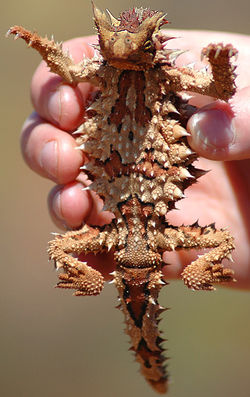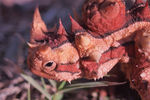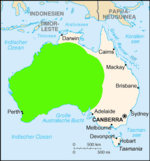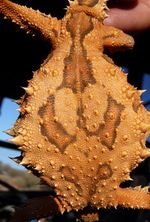Thorny devil
| Thorny devil |
|---|
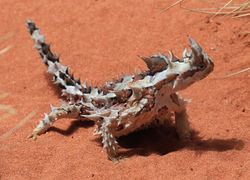
|
| Scientific Classification |
| Scientific Name |
|
Moloch horridus |
| The Underside of the Moloch horridus |
The Thorny Devil is a species of lizard native to Australia that is known by the scientific name Moloch horridus. They are found in the deserts, and since there are rare occasions of water, these lizards can receive water from eating ants, or letting dew drops soak into their skin.
These lizards can be up to 10 inches in length, and eat mostly ants. Though they may be small and slow, they have spikes on their back to protect them from predators.
Body Design
The Thorny Devil (Moloch horridus) is a lizard that has thorns all over it. [2] They can drink water through pores between the spikes and scales on the lizards. The water that touches their pores on their scales gets moved trough capillary actions to its mouth. This allows the Thorny Devil to drink from anywhere from the body. [3]
These lizards can also change the color of their scales, according to weather conditions, or when alarmed. When the Thorny devil is in warmer conditions, it changes its scales to the color of light yellow, and red. When threatened or cold, they turn into darker colors, to blend with the dark, or look closer to piles of sticks.[3] The thorny devil can reach up to 6-10 inches in length, and also be very bulky. The body of the Thorny Devil is brown and tan, to match the desert colors and blend to their surroundings. Another trait that makes the lizard special, is that it has a "second head". This is to confuse predators as if the lizard is bigger, and if it was looking at them from behind. [2]
Life Cycle
The Thorny Devil (Moloch horridus) are lizards that reach full size at 6 years old, and reach sexual maturity at 3 years. Although females are usually bigger than the males, the males have up to 18-20 years to live and get to full size. Their growth rate differs throughout the seasons. For example, they grow faster in water climates than in winter.[4]
The female lizards, can lay around 3-10 eggs usually in the time between September and December. They lay their eggs in an underground burrow, which serves as a nest, 30 centimeters to the ground. When the eggs are played, they incubate for 3-4 months, and the female loses over 35% of her body weight after giving birth.[4] Thorny devils ("Moloch horridus"), can breed only up to one time a year. These lizards are oviparous, which means they produce eggs, which hatch after being expelled out of the body. The average gestation period, would be around 118 days. [5]
Ecology
The Thorny Devil is native to Australia. They are most likely found in the sandy deserts, located in the inner parts of Australia. [6] These lizards have a diet of mostly ants, but hunt other small insects if hungry. These animals, are carnivores, and are also "sit and wait" animals, which means they wait outside of the ant mound, and eat when they come out. Examples of organisms that prey on the Moloch horridus, are the Australian bustards, goannas, and even humans. [7]
Defense Mechanisms
The Thorny Devil are preyed by many, such as the buzzards, monitor lizards, humans, and sand goannas.[8] To avoid getting killed, the lizard must have a few defensive characteristics. The first defensive trait, is the False head. The False head makes the lizard appear much larger when looking downwards, and also acts as a dummy, because there are no bones or tissue located there. If the false head was to be cut off, the Lizard can move on throughout life without any damage to the brain taken. [9] The second defensive trait that this lizard can do, is to inflate their body. When inflating their body, they can change their torso size up to 2x more, just by filling up their lungs with air. This will also make the spikes pop out larger, and at the same time, seem bigger.[10]
Video
References
- ↑ Moloch horridus WikiSpecies. Web. Last Accessed January 4, 2017. Author Unknown
- ↑ 2.0 2.1 Thorny Devil Description BioExpedition. Web. Published May 9, 2012. Author Unknown
- ↑ 3.0 3.1 Bates, Mary. 10 Fun Facts about the Thorny Devil WIRED. Web. Published September 1, 2014.
- ↑ 4.0 4.1 Sherbrooke, Wade. Life Cycle Reptiles Magazine. Web. Accessed January 4, 2017.
- ↑ Reproduction Encyclopedia of Life. Web. Accessed January 18, 2017. Author Unknown
- ↑ Dewey, Tanya. Geographic Range Animal Diversity Web. Web. Accessed January 18, 2017.
- ↑ Dewey, Tanya. Food Habits Animal Diversity Web. Web. Accessed January 18, 2017.
- ↑ Dewey, Tanya. Known Predators ADW. Web. Accessed January 30, 2017.
- ↑ Defense Mechanisms Outback Australia. Web. Accessed January 30, 2017. Author Unknown
- ↑ Sherbrooke, Wade. Deterring Predation ReptilesMagazine. Web. Accessed January 30, 2017.
